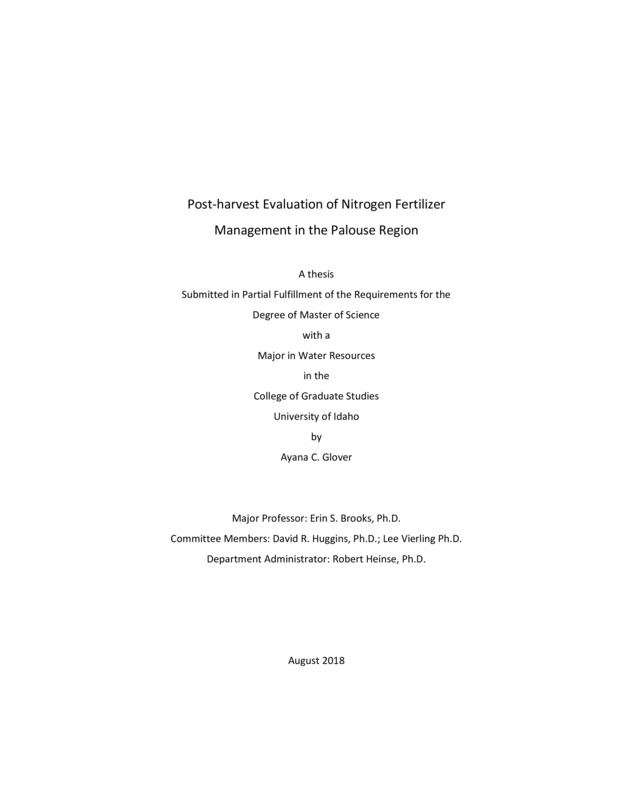Post-harvest Evaluation of Nitrogen Fertilizer Management in the Palouse Region
Glover, Ayana. (2018-08). Post-harvest Evaluation of Nitrogen Fertilizer Management in the Palouse Region. Theses and Dissertations Collection, University of Idaho Library Digital Collections. https://www.lib.uidaho.edu/digital/etd/items/glover_idaho_0089n_11342.html
- Title:
- Post-harvest Evaluation of Nitrogen Fertilizer Management in the Palouse Region
- Author:
- Glover, Ayana
- ORCID:
- 0000-0002-2623-4281
- Date:
- 2018-08
- Keywords:
- economics evaluation nitrogen efficiency remote sensing satellite imagery spatial
- Program:
- Water Resources
- Subject Category:
- Agriculture; Agriculture economics; Agronomy
- Abstract:
-
Inefficient use of nitrogen from agricultural systems is a driving factor of chronic and acute environmental degradation (Chen et al., 2006, 2011, 2014, Fuentes et. al., 2003, Brye et. al., 2001, Zhao et. al., 2006) resulting in environmental dilapidation, increased human health risks (Knobeloch et al., 2000) and potential losses in agricultural productivity (Jennings, 1990, Mahler et al., 1985, Bezdicek et al., 2003). Although precision agriculture practices seek to decrease N losses and subsequent costs (Ward et al., 2018, Basso et al. 2010, 2011; Zhang et al. 2010), adoption of precision agriculture is not widespread in the inland Pacific Northwest (Ward et al., 2018). In the Palouse region, four fields were observed (with up to 25 data points at each location) over a five-year period to evaluate and develop integrated post-harvest evaluation strategies to maximize profits and minimize environmental impact of fertilizer management practices. Crop and soil samples were collected at each farm to measure the various factors of nitrogen use efficiency as defined by Huggins et al. (2010). These point data were evaluated for regional and topographic crop performance patterns. The nitrogen balance index (NBI = grain N/ N fertilizer) was directly related to N uptake (Correl = 0.80, R2= 0.50, RMSE = 0.11) and suggests satellite imagery could efficiently evaluate spatial patterns of crop performance and profitability. Satellite imagery was correlated with crop N content and evaluated for spatial drivers in N variability. The normalized difference red edge index (NDRE) was directly related to grain N content (R2= 0.59, RMSE = 28.1 kg/ha) by wheat class (hard red and soft white in this study). Crop performance ranged widely and was highly dependent on seasonal weather conditions; however, evidence suggests that stable spatial patterns exist and are correlated to apparent soil electrical conductivity. Grain N content and yield maps successfully demonstrated field scale evaluation of crop performance classification and profitability. The positive relationship between NBI and profitability (field specific R2 ranging 0.60-0.92) suggests implementing adaptive fertilizer management strategies will result in profitable returns and reduced environmental impact. The pairing of satellite imagery with effective evaluation metrics enables informed sampling by effectively capturing variable crop performance allowing effective evaluation of fertilizer management practices.
- Description:
- masters, M.S., Water Resources -- University of Idaho - College of Graduate Studies, 2018-08
- Major Professor:
- Brooks, Erin S
- Committee:
- Huggins, David R; Vierling, Lee
- Defense Date:
- 2018-08
- Identifier:
- Glover_idaho_0089N_11342
- Type:
- Text
- Format Original:
- Format:
- application/pdf
- Rights:
- In Copyright - Educational Use Permitted. For more information, please contact University of Idaho Library Special Collections and Archives Department at libspec@uidaho.edu.
- Standardized Rights:
- http://rightsstatements.org/vocab/InC-EDU/1.0/

